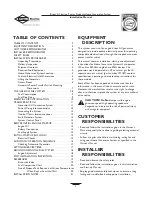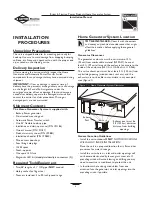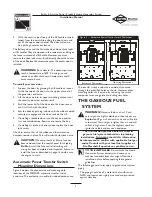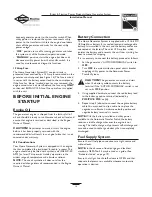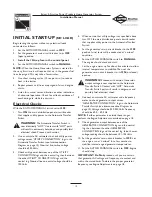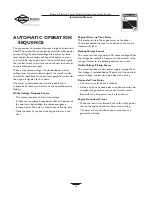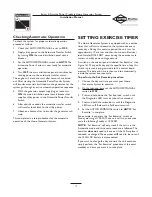
5
Briggs & Stratton Power Products Home Generator System
Installation Manual
• Install the generator as close as possible to the
Automatic Power Transfer System to reduce the length
of wiring and conduit.
• Install the generator as close as possible to the fuel
supply to reduce length of pipes.
CAUTION!
Laws or local codes may regulate the
distance to the fuel supply.
The Home Generator System is shipped already attached
to its mounting pad. Unless mandated by local code, no
concrete slab is required.
If mandated by local code, detach the unit from its supplied
base. Construct a concrete slab at least 3 inches thick and
6 inches longer and wider than the unit. Attach unit to slab
with 1/4” diameter (minimum) masonry anchor bolts long
enough to retain the unit. Use the mounting pad holes as
anchor bolt locators.
Fuel and Electrical Inlet Dimensions
Figure 2, below, depicts the physical location of the fuel
piping connector. Also shown is the recommended location
for punching holes for attaching the power and signal
conduits.
Lifting the Generator
The generator weighs more than 375 pounds. Proper tools,
equipment and qualified personnel should be used in all
phases of handling and moving the unit.
CAUTION!
Do Not lift unit by roof as damage to unit
will occur.
Two 4ft. lengths of 1” O.D. pipe (supplied by the installer)
are required to lift the generator manually. Insert pipes
through the lifting holes located near the unit’s base, as
shown in Figure 3 (next page).
CAUTION!
The unit may shift on the lifting pipes
during movement, which may cause an injury.
WARNING!
If lifting or hoisting equipment is
used, be careful not to touch any overhead power
lines.
Figure 2 — Generator Fuel and Conduit Attachment Locations, Oil Service Side of Unit
3/4” NPT
Fuel Piping
Connector
Recommended
Conduit Attachment
Area
4.5”
13.5”


